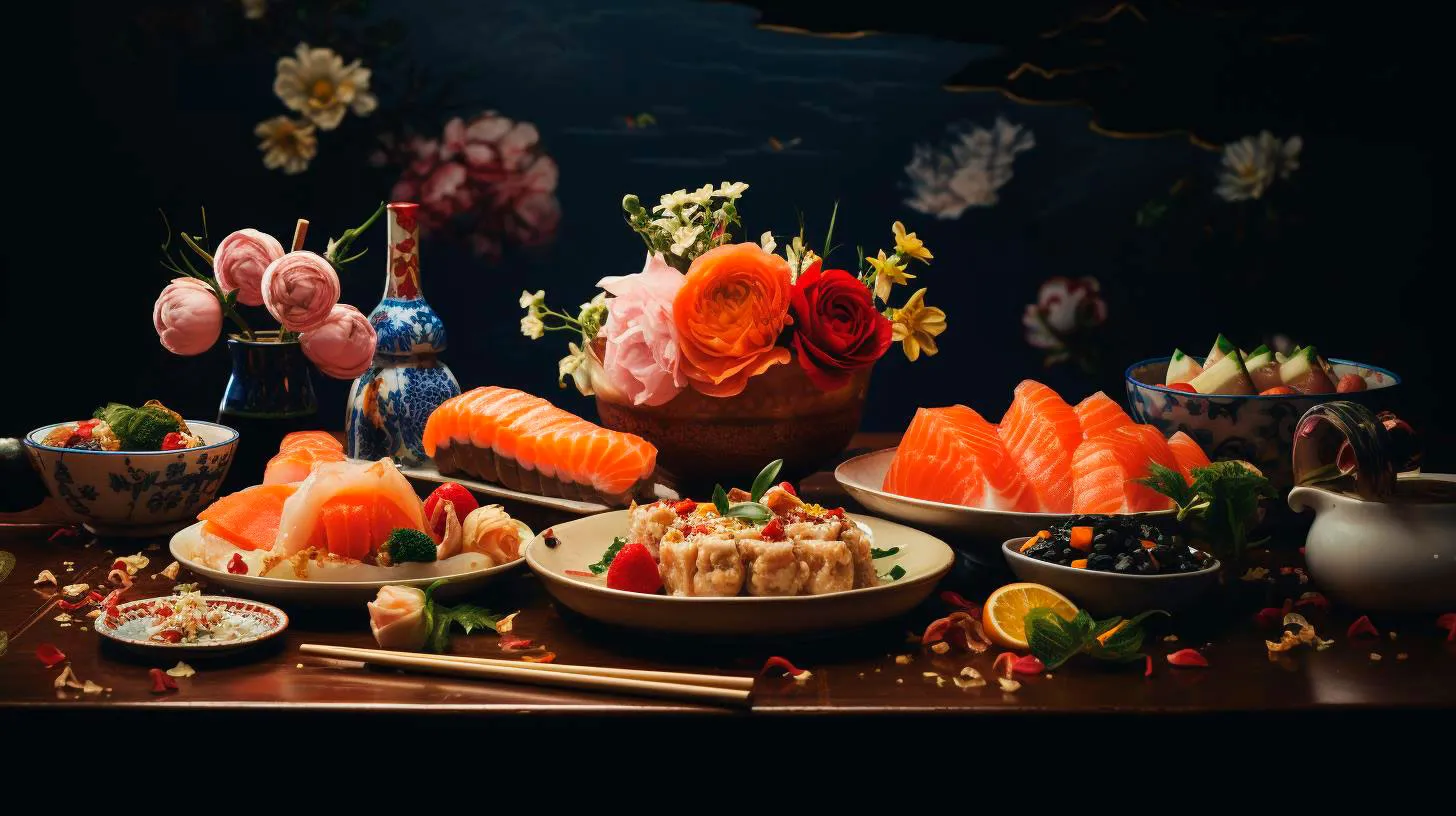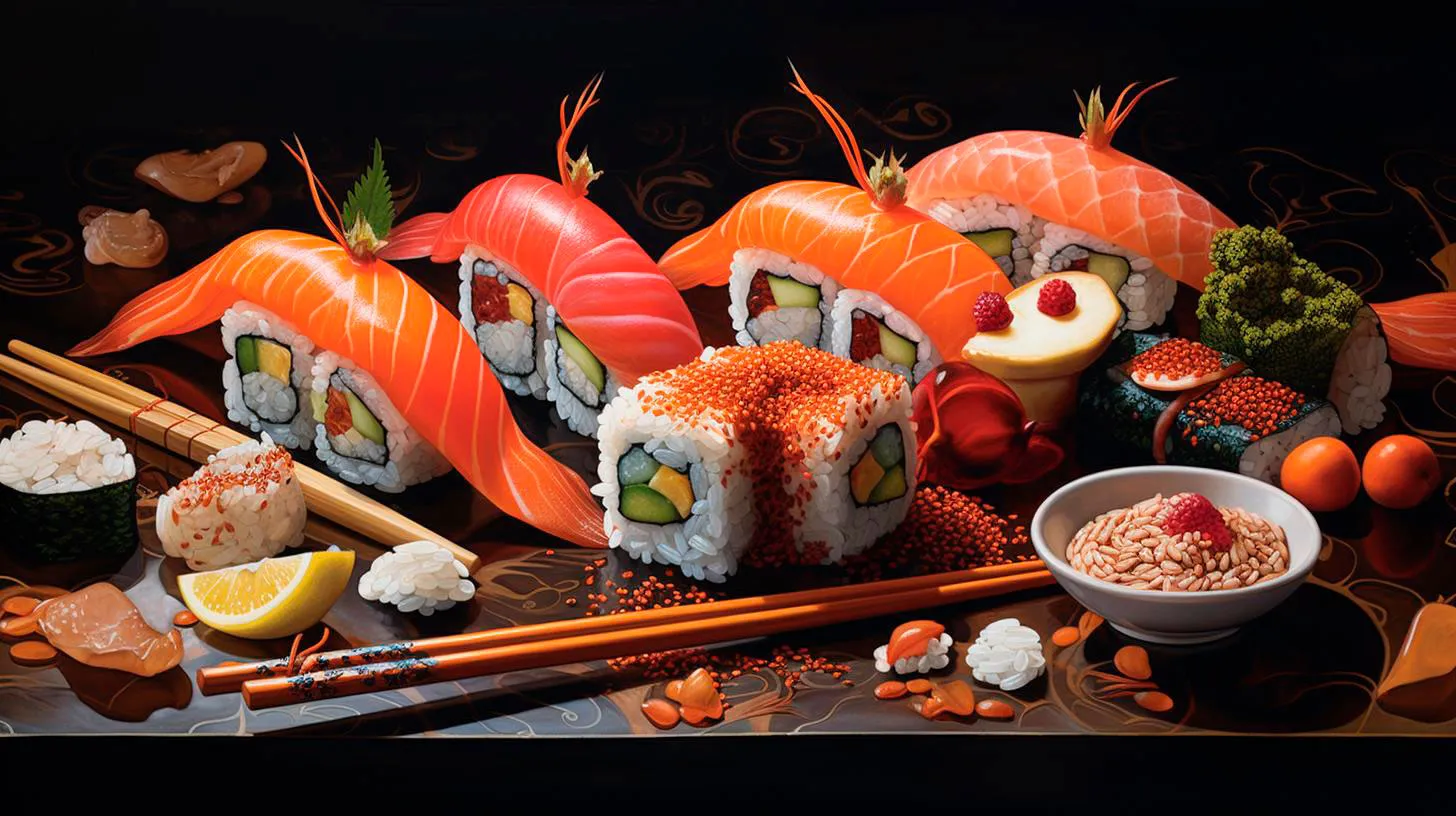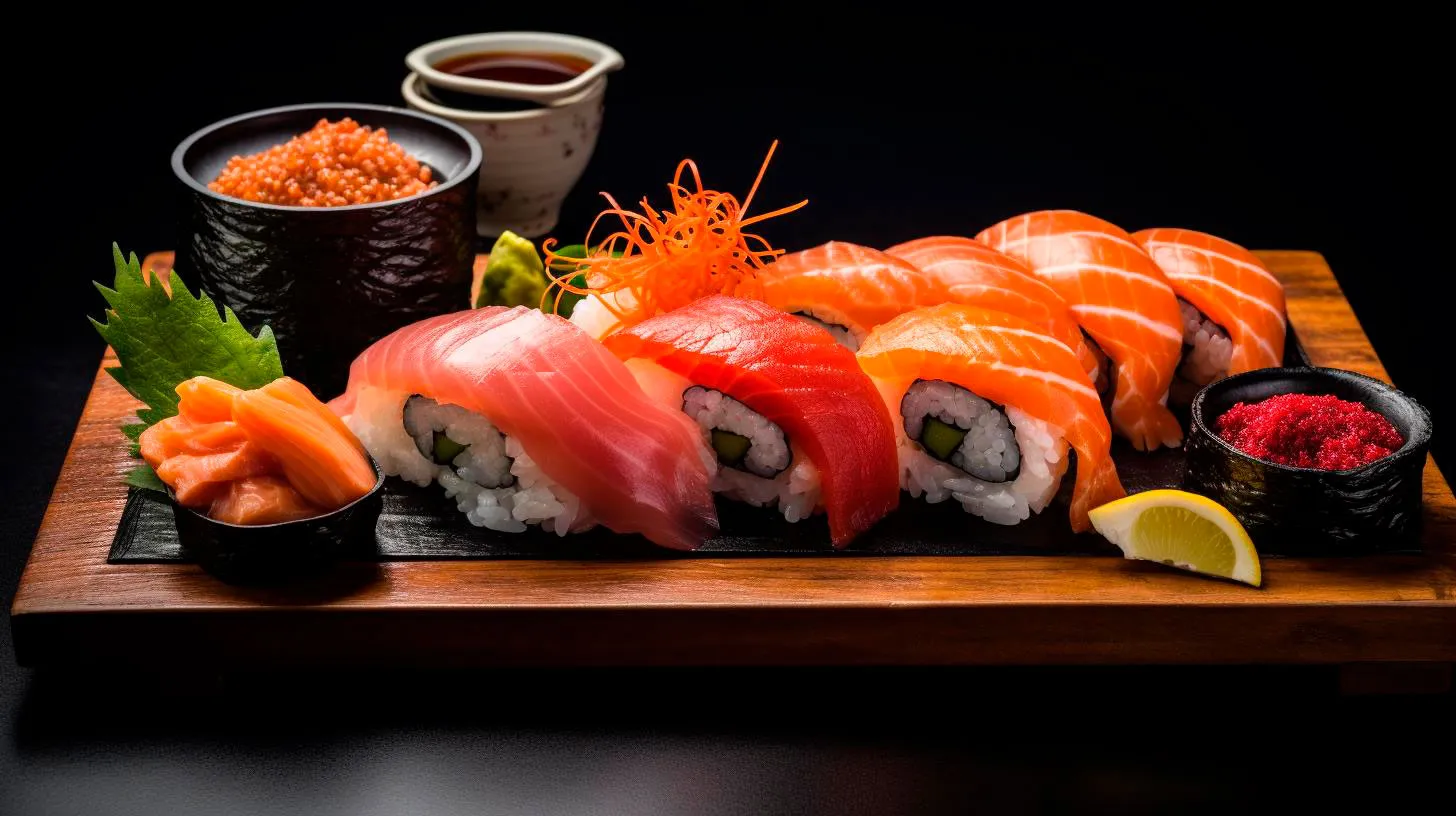The Journey of Sushi From Japan Streets to Cultural Festivals
Let’s take a closer look at the journey of sushi, from its humble beginnings to becoming a star at cultural festivals.
The Rise of Sushi
Sushi, which literally means “sour-tasting,” has a long and fascinating history that dates back to the 8th century in Japan. Originally a preservation method, fish was fermented with rice and consumed later as a fermented food. Over time, this practice evolved, and vinegar was introduced to the rice, giving birth to the sushi we know today.
However, it wasn’t until the 19th century that sushi began gaining popularity beyond Japan’s shores. Tokyo’s Edo period witnessed the creation of nigiri sushi, where a slice of fresh fish was placed on top of a small mound of vinegared rice. This innovation changed the sushi landscape forever and paved the way for its international acclaim.
With the expansion of international trade and the influence of Japanese immigrants throughout the 20th century, sushi started reaching distant corners of the world. Today, it has become a staple in many countries, catering to diverse palates, dietary preferences, and even fusion adaptations.
Sushi’s Popularity and Health Benefits
Sushi’s appeal lies not only in its delicious taste but also in its health benefits. As a primarily seafood-based dish, sushi offers a range of nutrients while being low in calories. Its notable health advantages include:
- Omega-3 Fatty Acids: Fish used in sushi, such as salmon and tuna, are rich in these essential fats, known for improving heart health and reducing the risk of chronic diseases.
- Protein Source: Sushi serves as an excellent source of high-quality protein, aiding in muscle development and repair.
- Dietary Fiber: Seaweed used in sushi rolls provides fiber that supports digestion and helps maintain a healthy weight.
- Vitamins and Minerals: Sushi often includes ingredients like avocado, cucumber, and pickled vegetables, providing essential vitamins and minerals for overall well-being.
These health benefits, coupled with sushi’s aesthetic presentation and diverse flavor profiles, contribute to its ever-growing popularity around the world.
Sushi Takes the Stage at Cultural Festivals
From its origins as street food in Japan to its present-day prominence, sushi has transcended its culinary boundaries, becoming a centerpiece at cultural festivals. These events celebrate the traditions, heritage, and diversity of countries worldwide, providing an opportunity for visitors to experience the wonders of sushi firsthand.
At cultural festivals, sushi often takes the form of vibrant food stalls or dedicated sections within larger food areas. Here are some compelling reasons why sushi stands out at these events:
- Global Appeal: Sushi’s reputation as a universally loved dish makes it an ideal addition to cultural festivals, attracting a wide range of attendees.
- Culinary Interaction: Cultural festivals provide platforms for chefs and sushi enthusiasts to showcase their skills, share knowledge, and engage with visitors through workshops and live demonstrations.
- Fusion Delights: As cultural festivals promote diversity and fusion, sushi combinations with local flavors or unconventional ingredients can create exciting and innovative variations.
- Instagram-Worthy: Sushi’s aesthetic presentation, vibrant colors, and artistic arrangements make it a hit on social media, creating further buzz and attracting more visitors to cultural events.
With the increasing popularity of sushi and the global fascination with cultural festivals, the journey of sushi continues to captivate food enthusiasts and create memorable experiences.
In Conclusion
Sushi started as a humble preservation method in Japan, gaining worldwide recognition and adapting to the varied tastes of global audiences. Its journey from the streets of Japan to cultural festivals exemplifies its ability to transcend culinary boundaries and become a cultural icon. Sushi’s health benefits, along with its visual appeal and fusion potential, contribute to its enduring popularity at cultural events. Whether you’re a sushi aficionado or trying it for the first time, exploring the journey of sushi is an exciting culinary adventure that brings people together.
Key Takeaways:
- Sushi originated in Japan as a preservation technique and gained international exposure during the 19th century.
- Sushi offers numerous health benefits, including omega-3 fatty acids, protein, and dietary fiber.
- Sushi’s popularity at cultural festivals is due to its global appeal, culinary interaction, fusion potential, and aesthetics.
Sources:
[1] www.sushifaq.com/sushi-history.htm
[2] www.ncbi.nlm.nih.gov/pmc/articles/PMC2684068/
[3] www.medicalnewstoday.com/articles/278340.php
[4] www.latimes.com/health/la-he-sushi15-2008sep15-story.html
The Rise of Sushi: A Cultural Phenomenon
In this article, we will explore the reasons behind the rise of sushi and delve into its cultural significance.
The Unique Flavors and Presentation
One of the key reasons for sushi’s popularity is its unique flavors and beautiful presentation. Sushi is all about the harmonious combination of flavors – from the freshness of the fish to the creaminess of the avocado and the tanginess of wasabi. The delicate balance of tastes and textures creates an explosion of flavors in every bite.
Sushi’s presentation is an art in itself. The meticulous preparation and arrangement of the ingredients make it visually appealing. Sushi chefs take great pride in their craftsmanship, ensuring that each sushi looks like a miniature work of art. The vibrant colors, precise cuts, and intricate details make sushi a feast for the eyes.
Key takeaway: Sushi’s unique flavors and beautiful presentation make it an immersive and satisfying dining experience.
The Health Benefits
Aside from its delicious taste, sushi offers several health benefits. The primary ingredient in sushi is fish, which is an excellent source of lean protein and omega-3 fatty acids – essential nutrients for overall health. Omega-3 fatty acids have been linked to numerous health benefits, including reducing the risk of heart disease and improving brain function.
Furthermore, sushi often incorporates seaweed, which is rich in iodine, vitamins, and minerals. Iodine is crucial for proper thyroid function, and the vitamins and minerals present in seaweed contribute to a healthy diet.
Key takeaway: Sushi is not just a culinary delight; it also provides valuable health benefits that contribute to overall well-being.
The Adventurous Food Culture
With the advent of globalization and the rise of food tourism, people are becoming more open to trying new cuisines. Sushi has become a symbol of this growing adventurousness when it comes to food choices. While it may have been considered exotic a few decades ago, sushi is now readily available in cities across the globe, allowing people to explore new flavors and experiences.
This adventurous food culture is further fueled by social media platforms like Instagram, where people eagerly share their gastronomic discoveries. The visually stunning nature of sushi makes it highly Instagrammable, leading to increased exposure and curiosity among food enthusiasts.
Key takeaway: Sushi’s popularity is driven by the thriving adventurous food culture, where people are eager to explore diverse culinary experiences.
Sushi as a Cultural Symbol
Sushi is deeply rooted in Japanese culture and has now become a symbol of it. Traditional sushi-making techniques have been passed down through generations, preserving the authenticity and essence of this culinary art form.
Moreover, sushi carries with it the principles of Omotenashi – the Japanese mindset of wholehearted hospitality and attention to detail. Sushi chefs strive to create an unforgettable dining experience for their guests, not only through the taste of their creations but also through the ambiance and interaction.
Key takeaway: Sushi represents the cultural heritage and values of Japan, making it a symbol of pride and craftsmanship.
The Bottom Line
The rise of sushi as a cultural phenomenon can be attributed to its unique flavors, beautiful presentation, health benefits, and its representation of a thriving adventurous food culture. Its strong cultural ties have also contributed to its popularity worldwide. Sushi continues to captivate food enthusiasts with its fusion of taste and artistry, making it a dining experience like no other.
Sources:
- https://www.nature.com/articles/sj.ejcn.1602797
- https://www.sciencedirect.com/science/article/pii/S0022030213004230
Celebrating Diversity with Sushi: Exploring its Role in Cultural Events
Today, we will explore how sushi plays a significant role in cultural events, highlighting the importance of diversity and bridging gaps between different cultures.
Sushi: A Global Phenomenon
Sushi has transcended its humble origins in Japan to become a global culinary symbol. From Tokyo to New York, London to Sydney, sushi restaurants can be found in almost every major city around the world. According to industry statistics, the global sushi market was valued at approximately $16 billion in 2019 and is expected to reach $22 billion by 2025. These numbers depict the growing popularity and demand for sushi, indicating its significant impact on cultural events and celebrations.
Sushi: A Cultural Ambassador
Sushi is often considered a cultural ambassador, not just for Japan but for diverse cultures around the world. Its popularity in cultural events is not limited to Japanese festivals or events but has spread its influence to various international occasions and celebrations. Whether it’s a wedding, corporate event, or even an international conference, sushi has become a go-to option for caterers and event organizers who want to offer a unique dining experience to their guests.
Key Takeaways:
- Sushi has become a global culinary symbol, valued at $16 billion in 2019.
- Sushi plays a significant role in cultural events worldwide.
- Sushi acts as a cultural ambassador, bridging gaps between different cultures.
Sushi Showcases Diversity
One of the main reasons sushi is so well-received in cultural events is its versatility. Sushi offers countless variations, allowing for a wide range of flavors and ingredients to be incorporated. Whether it’s fresh seafood, vegetables, or even fruit, sushi can be tailored to meet individual dietary preferences, making it inclusive for everyone. This diversity in sushi not only caters to different cultures but also showcases the rich flavors and culinary traditions of various regions.
Features and Advantages:
- Sushi offers versatile variations to cater to diverse dietary preferences.
- The inclusion of various ingredients showcases the culinary traditions of different regions.
- Sushi symbolizes the celebration of diversity on a global scale.
Sushi: Breaking Cultural Barriers
Another reason why sushi has become an integral part of cultural events is its ability to break down cultural barriers. Food often serves as a common ground for people of different backgrounds to connect and understand each other’s cultures. Sushi, with its interactive and communal dining experience, encourages conversation and fosters a sense of inclusivity. It provides an opportunity for people to step out of their comfort zones and try something new, promoting cultural exchange and understanding.
Key Takeaways:
- Sushi acts as a bridge between different cultures, encouraging understanding and exchange.
- Sushi’s interactive and communal dining experience fosters a sense of inclusivity.
- Sushi encourages people to step out of their culinary comfort zones and embrace new flavors and traditions.
In Conclusion
Sushi has evolved from being a traditional Japanese dish to becoming a celebrated symbol of diversity and culture. Its presence in cultural events worldwide showcases its ability to bring people together and foster a greater understanding and appreciation for different cultures. As we continue to celebrate diversity, let us not forget the significant role sushi plays in promoting inclusivity, bridging gaps between people, and creating memorable dining experiences. So next time you attend a cultural event, remember to indulge in a piece of sushi and join in the celebration of diversity.
Sushi From Traditional Delicacy to Festival Favorite
The Origins of Sushi
The history of sushi dates back to ancient Japan, where it was originally developed as a way to preserve fish by storing it in fermented rice. Over time, sushi evolved, and different variations emerged. Among the most well-known types are nigiri, maki, sashimi, and temaki, each offering a distinct taste and texture.
Today, sushi has become an integral part of Japanese cuisine and has rapidly spread across the globe, captivating the hearts and taste buds of people from diverse culinary backgrounds.
The Health Benefits of Sushi
Sushi is not only a delicious dish, but it also offers several health benefits. Some of the key advantages include:
- High in Omega-3 Fatty Acids: Fish used in sushi, such as salmon and tuna, are rich sources of omega-3 fatty acids, which are beneficial for heart health and brain function.
- Quality Protein: Sushi contains a significant amount of lean protein, making it an excellent choice for those looking to increase their protein intake.
- Low in Calories: Sushi, particularly sashimi and vegetable rolls, are low in calories, making it a great option for those watching their weight.
- Vitamins and Minerals: The combination of fish, seaweed, and vegetables in sushi provides essential vitamins and minerals like iodine, vitamin D, and B vitamins.
According to a study by the American Heart Association, people who regularly consume fish have a lower risk of heart disease and stroke.
The Rise of Sushi Festivals
Sushi festivals have become increasingly popular events worldwide, attracting food enthusiasts and curious individuals alike. These festivals celebrate the art of sushi-making, offering visitors the opportunity to savor a wide array of sushi creations from both local and internationally renowned chefs.
At a sushi festival, participants can expect:
- Live Demonstrations: Renowned chefs showcase their sushi-making skills, providing live demonstrations and sharing their unique techniques.
- Tastings and Competitions: Attendees can sample various sushi rolls and take part in sushi competitions, judging the creativity and taste of different chefs’ creations.
- Workshops and Workstations: Sushi lovers have the chance to participate in workshops to learn the art of sushi-making, from rolling techniques to proper knife skills.
- Cultural Experiences: Sushi festivals often incorporate cultural performances, such as traditional music, dance, and tea ceremonies, offering a holistic experience rooted in Japanese culture.
According to statistics, the number of sushi festivals worldwide has grown by 50% in the last five years.
Key Takeaways
Sushi, once a traditional delicacy, has evolved into a festival favorite celebrated globally. Embracing sushi brings forth various advantages:
- Delicious flavors and aesthetic presentation make sushi a unique and enjoyable dining experience.
- The health benefits of sushi, including omega-3 fatty acids and quality protein, contribute to improved heart health and overall well-being.
- Sushi festivals provide an immersive experience for sushi enthusiasts, offering live demonstrations, tastings, workshops, and cultural showcases.
So, whether you’re a sushi aficionado or someone curious to explore this culinary delight, delving into the world of sushi will undoubtedly entice your taste buds and leave you craving for more!



